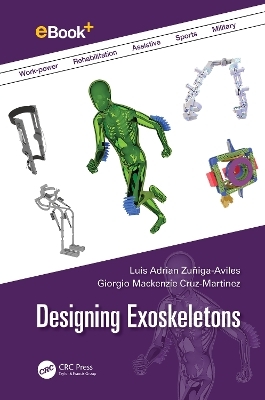
Designing Exoskeletons
CRC Press (Verlag)
978-1-032-20047-7 (ISBN)
Designing Exoskeletons focuses on developing exoskeletons, following the lifecycle of an exoskeleton from design to manufacture. It demonstrates how modern technologies can be used at every stage of the process, such as design methodologies, CAD/CAE/CAM software, rapid prototyping, test benches, materials, heat and surface treatments, and manufacturing processes. Several case studies are presented to provide detailed considerations on developing specific topics.
Exoskeletons are designed to provide work-power, rehabilitation, and assistive training to sports and military applications. Beginning with a review of the history of exoskeletons from ancient to modern times, the book builds on this by mapping out recent innovations and state-of-the-art technologies that utilize advanced exoskeleton design. Presenting a comprehensive guide to computer design tools used by bioengineers, the book demonstrates the capabilities of modern software at all stages of the process, looking at computer-aided design, manufacturing, and engineering. It also details the materials used to create exoskeletons, notably steels, engineering polymers, composites, and emerging materials. Manufacturing processes, both conventional and unconventional are discussed—for example, casting, powder metallurgy, additive manufacturing, and heat and surface treatments.
This book is essential reading for those in the field of exoskeletons, such as designers, workers in research and development, engineering and design students, and those interested in robotics applied to medical devices.
Dr. Adrian Zuñiga is a Professor in the Bioengineering bachelor of Faculty of Medicine UAEMex, member of Mexican Researchers National System level II and Retired Military Engineer with vast experience in the development of medical devices. He holds a Ph.D. and a master's degree in Science and Technology on Mechatronics from the Center for Engineering and Industrial Development (CIDESI). He holds a bachelor's degree in Military Industrial Engineering and mechanical engineering specialty from the Military School of Engineers (EMI), Mexican Army and Air force University. Dr. Zuñiga has led several designs and development of crane systems for lift patients, exoskeletons, rehabilitation devices, aid devices, and prosthetics. Some products are working in the Mexican Central Military Hospital. His experience has focused on New Product Development, design process, design methodologies, design of mechanisms and machines, test benches, finite element method (FEM) analysis, kinematics, modeling and simulation, manufacturing technologies, and rapid prototypes. He has authored over 200 works, including conference presentations, proceedings, book chapters, patents, articles, projects, and industrial reports. Nowadays, Dr. Zuñiga is a member of the Dynamics and Control Systems in the Faculty of Engineering at the Autonomous University of Mexico State. Dr. Giorgio Mackenzie Cruz Martínez is an electronic engineer who graduated from the Autonomous University of Mexico State. He also realized his master's and Ph.D. studies at this University; he also participates in a military project with the Applied Research Center and Technology Development for the Mexican Military Industry (CIADTIM). He has broad experience in designing and manufacturing rehabilitation robots and exoskeletons. He did a postdoctoral research stay at the informatic, robotic, and microelectronic laboratory of Montpellier in France, working on the development of a robot surgery device. His experience has focused on New Product Development, design process, design methodologies, medical mechanisms, instrument design, kinematics modeling and simulation, and rapid prototypes. Dr. Giorgio is a member of the research group on Dynamics and Control Systems in the Faculty of Engineering at the Autonomous University of Mexico State and is part of the National Research System
Chapter 1 History of the Exoskeletons
Chapter 2 Types and application of Exoskeletons
Chapter 3 Design Methodologies
Chapter 4 Design of Exoskeletons
Chapter 5 Technology readiness level in the exoskeleton’s development
Chapter 6 Standards
Chapter 7 Test benches and protocols
Chapter 8 Usability analysis
Chapter 9 Intellectual property
| Erscheinungsdatum | 29.03.2024 |
|---|---|
| Zusatzinfo | 24 Tables, black and white; 70 Line drawings, black and white; 32 Halftones, black and white; 102 Illustrations, black and white |
| Verlagsort | London |
| Sprache | englisch |
| Maße | 156 x 234 mm |
| Gewicht | 662 g |
| Themenwelt | Informatik ► Weitere Themen ► CAD-Programme |
| Medizin / Pharmazie ► Physiotherapie / Ergotherapie ► Orthopädie | |
| Technik ► Elektrotechnik / Energietechnik | |
| Technik ► Medizintechnik | |
| Technik ► Umwelttechnik / Biotechnologie | |
| ISBN-10 | 1-032-20047-2 / 1032200472 |
| ISBN-13 | 978-1-032-20047-7 / 9781032200477 |
| Zustand | Neuware |
| Informationen gemäß Produktsicherheitsverordnung (GPSR) | |
| Haben Sie eine Frage zum Produkt? |
aus dem Bereich


